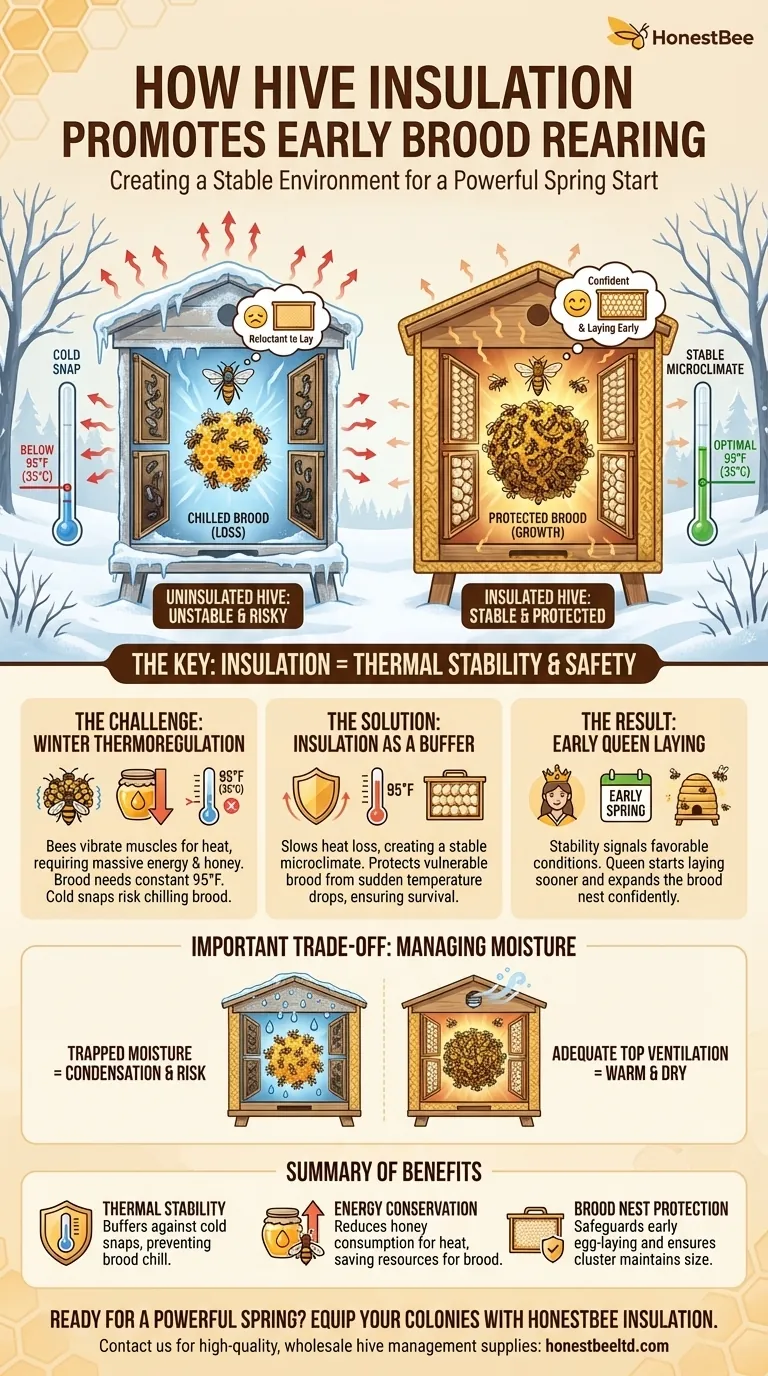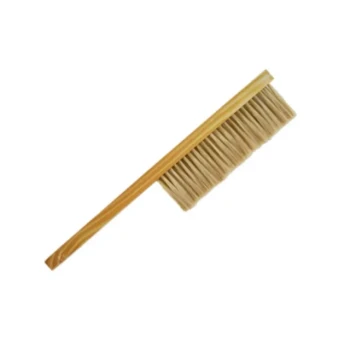In short, hive insulation works by creating a stable environment. It reduces the energy bees must expend to maintain the ideal brood-rearing temperature and, crucially, buffers the vulnerable brood from sudden, late-season cold snaps. This stability and safety signal to the queen that it is safe to begin laying earlier in the season.
The primary benefit of insulation is not just warmth, but thermal stability. By slowing heat loss, insulation allows the colony to maintain the necessary 95°F (35°C) for brood development with less effort and less risk, giving them a critical head start on spring.
The Challenge of Winter Thermoregulation
To understand why insulation is effective, we must first understand the challenges a honey bee colony faces as it transitions from winter to spring.
The Bee Cluster's Job
During cold weather, honey bees form a tight cluster to generate and conserve heat. They create warmth by vibrating their powerful flight muscles, a process that requires a tremendous amount of energy.
The outer layer of this cluster acts as an insulating shell, while the bees in the center generate the heat necessary to keep the colony and their queen alive.
The Strict Demands of Brood
Raising young bees (brood) requires a precise temperature of approximately 95°F (35°C). Maintaining this temperature is non-negotiable for healthy development.
If the temperature drops too low, the brood can become chilled and die. This makes starting a new generation in late winter a high-stakes gamble for the colony.
The High Cost of Heat
Generating this heat consumes the colony's primary fuel source: honey. The colder the outside air, the more honey the bees must consume just to maintain the survivable temperature of the cluster, let alone the ideal temperature for raising brood.
How Insulation Changes the Equation
Insulation fundamentally alters the physics of the hive, making the bees' job easier and safer. It provides a passive benefit that has a major impact on the colony's decision-making.
Creating a Stable Microclimate
Insulation acts as a thermal buffer, dramatically slowing the rate at which heat escapes the hive. This means the internal temperature remains much more stable, regardless of sharp fluctuations in the outside weather.
A sudden overnight freeze has a far less severe impact inside an insulated hive than an uninsulated one. This stability is the key.
Protecting the Vulnerable Brood Nest
This buffering effect directly protects the most vulnerable members of the colony. When the queen begins laying in a small patch, the colony must work hard to keep that area at 95°F.
In an uninsulated hive, a late cold snap can force the cluster to contract, leaving brood on the edges of the frame to perish. Insulation helps the cluster maintain its size and temperature, safeguarding that early investment in the next generation.
Encouraging the Queen to Lay
A consistently stable and warm internal environment is a powerful signal to the queen and the colony. It indicates that conditions are favorable and that the risk of investing resources into raising new bees is lower.
This encourages the queen to start laying earlier and to expand the brood nest more confidently, leading to a larger workforce emerging right as the first spring nectar flows begin.
Understanding the Key Trade-off: Moisture
While insulation provides significant thermal benefits, it introduces one critical challenge that must be managed.
The Danger of Trapped Moisture
Bees release a significant amount of moisture through respiration. In a well-insulated but poorly ventilated hive, this warm, moist air will rise and condense on cold inner surfaces, often the inner cover.
This condensation can then drip down onto the cluster, chilling and killing the very bees the insulation was meant to protect. Wet bees are dead bees.
The Need for Ventilation
Therefore, insulation must always be paired with adequate top ventilation. A small upper entrance or a dedicated ventilation port allows this moist air to escape before it can condense and cause harm. The goal is to retain heat while expelling excess moisture.
Making the Right Choice for Your Goal
Applying this knowledge effectively depends on your primary objective for the colony.
- If your primary focus is rapid spring build-up: Use insulation to protect the expanding brood nest from temperature shocks, allowing the queen to lay without interruption.
- If your primary focus is conserving winter food stores: Insulate to reduce the colony's energy expenditure on heat generation, ensuring they have more honey available for raising brood.
- If your primary focus is overall hive health: Always combine insulation with proper top ventilation to create a warm and dry environment that prevents mold and disease.
Properly applied insulation gives your colony the stability it needs to translate winter survival into a powerful spring start.
Summary Table:
| Key Benefit of Hive Insulation | How It Promotes Early Brood Rearing |
|---|---|
| Thermal Stability | Creates a stable microclimate, buffering against sudden cold snaps that can chill brood. |
| Energy Conservation | Reduces honey consumption for heat, freeing up resources for raising young bees. |
| Brood Nest Protection | Helps the cluster maintain size and temperature, safeguarding the queen's early egg-laying. |
Ready to give your colonies the head start they need for a powerful spring?
HONESTBEE supplies commercial apiaries and beekeeping equipment distributors with the high-quality, wholesale-focused supplies necessary for effective hive management. Proper insulation is a cornerstone of this strategy. Our durable equipment and expert support help you achieve the stable, productive hives that lead to greater honey yields and healthier colonies.
Contact us today to discuss your wholesale needs and how our solutions can support your success.
Visual Guide

Related Products
- Professional Insulated Winter Hive Wrap for Beekeeping
- Inner Beehive Cover for Beekeeping Bee Hive Inner Cover
- Professional Galvanized Hive Strap with Secure Locking Buckle for Beekeeping
- HONESTBEE Classic Pry Bar Hive Tool with High Visibility Finish for Beekeeping
- Endless Loop Ratchet Hive Strap
People Also Ask
- Why is insulation important for hives during winter? Ensure Your Bees Survive and Thrive
- What is the advantage of an insulated outer cover? Boost Winter Survival & Spring Buildup
- Why is it important to insulate beehives during winter? Boost Your Colony's Survival Rate
- What are the steps to properly wrap a beehive for winter? Ensure Your Colony Survives the Cold
- What are the benefits of insulated beehives in cold weather? Boost Winter Survival & Spring Productivity



















